NURSING MISC
Marshalltown Community College
Page 3 out of 45 results
Sort by
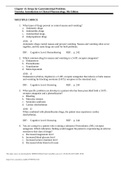
-
Chapter 13: Drugs for Gastrointestinal Problems Vislosky: Introduction to Clinical Pharmacology, 9th Edition
- Exam (elaborations) • 7 pages • 2022
-
- $7.49
- + learn more
Chapter 13: Drugs for Gastrointestinal Problems Vislosky: Introduction to Clinical Pharmacology, 9th Edition MULTIPLE CHOICE 1. What types of drugs prevent or control nausea and vomiting? a. Antiemetic drugs b. Antimotility drugs c. Antidiarrheal drugs d. Ant propulsion drugs ANS: A Antiemetic drugs control nausea and prevent vomiting. Nausea and vomiting often occur together, and the same drugs are used for both problems. DIF: Cognitive Level: Remembering REF: p. 242 2. Which common...
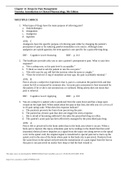
-
Chapter 11: Drugs for Pain Management Vislosky: Introduction to Clinical Pharmacology, 9th Edition
- Exam (elaborations) • 6 pages • 2022
-
- $7.49
- + learn more
MULTIPLE CHOICE 1. What types of drugs have the main purpose of relieving pain? a. Anticholinergics b. Antagonists c. Analgesics d. Agonists ANS: C Analgesics have the specific purpose of relieving pain either by changing the patient’s perception of pain or by reducing painful stimulation at its source. Although some analgesics are opioid agonists, the term agonist is not specific for a pain-relieving drug. DIF: Cognitive Level: Knowing REF: p. 213 2. The healthcare provider asks yo...
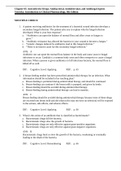
-
Chapter 05: Anti-infective Drugs: Antibacterial, Antitubercular, and Antifungal Agents Vislosky: Introduction to Clinical Pharmacology, 9th Edition
- Exam (elaborations) • 12 pages • 2022
-
- $7.99
- + learn more
MULTIPLE CHOICE 1. A patient receiving antibiotics for the treatment of a bacterial wound infection develops a secondary fungal infection. The patient asks you to explain why the fungal infection developed. What is your best response? a. “Antibiotics can upset the balance of normal flora and allow yeast or fungus to grow.” b. “Antibiotic resistance has allowed the bacteria in your wound to become a fungus.” c. “Genetic changes induced by antibiotics lead to this fungal infection...
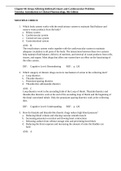
-
Chapter 08: Drugs Affecting the Renal/Urinary and Cardiovascular Problems Vislosky: Introduction to Clinical Pharmacology, 9th Edition
- Exam (elaborations) • 12 pages • 2022
-
- $7.99
- + learn more
MULTIPLE CHOICE 1. Which body system works with the renal/urinary system to maintain fluid balance and remove waste products from the body? a. Biliary system b. Cardiovascular system c. Central nervous system d. Gastrointestinal system ANS: B The renal/urinary system works together with the cardiovascular system to maintain adequate circulation to all parts of the body. The interactions between these two systems help maintain fluid balance, delivery of nutrients, and removal of waste p...
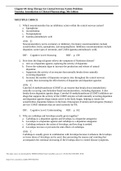
-
Chapter 09: Drug Therapy for Central Nervous System Problems Vislosky: Introduction to Clinical Pharmacology, 9th Edition
- Exam (elaborations) • 7 pages • 2022
-
- $7.49
- + learn more
MULTIPLE CHOICE 1. Which neurotransmitter has an inhibitory action within the central nervous system? a. Epinephrine b. Acetylcholine c. Norepinephrine d. Gamma-aminobutyric acid ANS: D Neurotransmitters can be excitatory or inhibitory. Excitatory neurotransmitters include acetylcholine (Ache), epinephrine, and norepinephrine. Inhibitory neurotransmitters include dopamine, some types of serotonin, and GABA (gamma-aminobutyric acid). DIF: Cognitive Level: Knowing REF: p. 159 2. How doe...
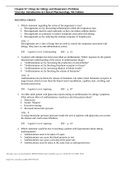
-
Chapter 07: Drugs for Allergy and Respiratory Problems Vislosky: Introduction to Clinical Pharmacology, 9th Edition
- Exam (elaborations) • 6 pages • 2022
-
- $7.49
- + learn more
MULTIPLE CHOICE 1. Which statement regarding the action of decongestants is true? a. Decongestants act by decreasing inflammation within the respiratory tract. b. Decongestants must be used cautiously as they can induce asthma attacks. c. Decongestants act primarily to reduce symptoms associated with allergy. d. Decongestants act by reducing the immune response of lymphocytes. ANS: C Decongestants are a class of drugs that are used to control the symptoms associated with allergy. They ha...
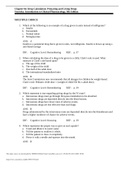
-
Chapter 04: Drug Calculation: Preparing and Giving Drugs Vislosky: Introduction to Clinical Pharmacology, 9th Edition
- Exam (elaborations) • 6 pages • 2022
-
- $7.49
- + learn more
MULTIPLE CHOICE 1. Which of the following is an example of a drug given in units instead of milligrams? a. Insulin b. Furosemide c. Normal saline d. Nitroglycerine ANS: A Insulin is a parenteral drug that is given in units, not milligrams. Insulin is drawn up using a unit-based syringe DIF: Cognitive Level: Remembering REF: p. 37 2. When calculating the dose of a drug to be given to a child, Clark’s rule is used. What measure is Clark’s rule based upon? a. The age of the child b...
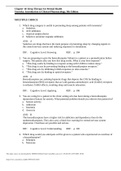
-
Chapter 10: Drug Therapy for Mental Health Vislosky: Introduction to Clinical Pharmacology, 9th Edition
- Exam (elaborations) • 8 pages • 2022
-
- $7.49
- + learn more
MULTIPLE CHOICE 1. Which drug category is useful in promoting sleep among patients with insomnia? a. Sedatives b. ACE inhibitors c. Atypical antipsychotics d. Selective serotonin reuptake inhibitors ANS: A Sedatives are drugs that have the main purpose of promoting sleep by changing signals in the central nervous system and reducing responses to stimulation. DIF: Cognitive Level: Knowing REF: p. 184 2. You are preparing to give the benzodiazepine Valium to a patient as a premedication ...
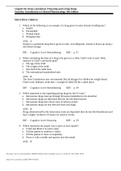
-
Chapter 04: Drug Calculation: Preparing and Giving Drugs Visovsky: Introduction to Clinical Pharmacology, 9th Edition
- Exam (elaborations) • 6 pages • 2022
-
- $10.49
- + learn more
1. Which of the following is an example of a drug given in units instead of milligrams? a. Insulin b. Furosemide c. Normal saline d. Nitroglycerine ANS: A Insulin is a parenteral drug that is given in units, not milligrams. Insulin is drawn up using a unit-based syringe DIF: Cognitive Level: Remembering REF: p. 37 2. When calculating the dose of a drug to be given to a child, Clark’s rule is used. What measure is Clark’s rule based upon? a. The age of the child b. The weight of t...
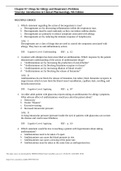
-
Chapter 07: Drugs for Allergy and Respiratory Problems Visovsky: Introduction to Clinical Pharmacology, 9th Edition
- Exam (elaborations) • 6 pages • 2022
-
- $10.49
- + learn more
MULTIPLE CHOICE 1. Which statement regarding the action of decongestants is true? a. Decongestants act by decreasing inflammation within the respiratory tract. b. Decongestants must be used cautiously as they can induce asthma attacks. c. Decongestants act primarily to reduce symptoms associated with allergy. d. Decongestants act by reducing the immune response of lymphocytes. ANS: C Decongestants are a class of drugs that are used to control the symptoms associated with allergy. They ha...

$6.50 for your textbook summary multiplied by 100 fellow students... Do the math: that's a lot of money! Don't be a thief of your own wallet and start uploading yours now. Discover all about earning on Stuvia


